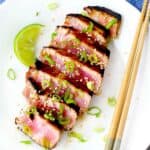Six-Minute Seared Ahi Tuna Steaks
These seared ahi tuna steaks take only 6 minutes to make- they're healthy, crispy and seared on the outside, and medium-rare on the inside, and bursting with umami flavor!
Servings: 2 servings
Calories: 331kcal
Equipment
Ingredients
- 2 ahi tuna (yellowfin tuna) steaks (about 4 oz. each, 1" thick - see notes for thinner or thicker)
- 2 tablespoons soy sauce preferably low sodium, see notes
- 1 tablespoon toasted sesame oil see notes
- 1 tablespoon honey see notes
- ½ teaspoon kosher salt optional, see notes
- 1/4 teaspoon black pepper to taste
- 1/4 teaspoon cayenne pepper (optional)
- 1 tablespoon oil canola, olive, or other high-heat cooking oil of preference
- green onions, toasted sesame seeds, and lime wedges for serving (optional)
Instructions
- Pat the 2 ahi tuna (yellowfin tuna) steaks dry with a paper towel. Place on a plate or inside a plastic bag.
- Mix the 2 tablespoons soy sauce, 1 tablespoon toasted sesame oil, 1 tablespoon honey, ½ teaspoon kosher salt (if using), 1/4 teaspoon black pepper, and 1/4 teaspoon cayenne pepper until honey is fully dissolved. Pour over the ahi tuna steaks and turn over to coat completely. Optional: allow to marinate for at least 10 minutes, or up to overnight in the refrigerator. Also optional: Reserve a spoonful or two of the marinade before coating the fish for drizzling on top after you've cooked it.
- Heat a medium skillet (preferably non-stick or a well-seasoned cast iron skillet) on medium-high to high until very hot ( or medium to medium-high for nonstick). I recommend giving cast iron 3-5 minutes to get hot and nonstick about 1 minute, depending on how thick it is.
- Add the 1 tablespoon oil to the hot pan. Sear the tuna for 1 - 1½ minutes on each side for medium rare ( 2 -2½ minutes for medium-well to well, 30 seconds for very rare. See notes - this will vary based on thickness of the tuna steaks). (Note: different burners get hotter depending on your stove. Use your best judgement whether you use medium, medium-high, or high heat, as the marinade may burn if too high heat is used)
- Remove to a cutting board. Slice into 1/2 inch slices and serve garnished with green onions, toasted sesame seeds, and lime wedges, if desired. If you find it needs more salt, I recommend sprinkling with flaky sea salt when serving.
Notes
- A note on soy sauce and added salt: many readers have commented that this recipe is too salty. I've updated the ingredients list and instructions to make the added kosher salt optional. The extra kosher salt works well for if you skip the marinating time and/or for thicker tuna steaks, or if you just like things on the saltier side. If you are unsure, I suggest omitting the added kosher salt and seasoning it to your liking when serving with salt (preferably flaky sea salt!) at the table. If you use regular soy sauce instead of low sodium, I would definitely recommend not using the added Kosher salt and seasoning it instead to taste when serving.
- For thinner or thicker tuna steaks, you may need less or more searing time. If you are using tuna steaks that are less than 1 inch, I recommend no more than 1 minute per side, depending on your preference for doneness. For thicker steaks, you may need to do 2 minutes per side. You may also need less searing time depending on the temperature of your fish- if it's been sitting out of the fridge for a while, it will take less time to cook.
- This recipe has been updated from its original. It had a simpler marinade of 2 tablespoons soy sauce, 1 tablespoon canola oil, salt, and pepper before. If you're short on ingredients (like toasted sesame oil and honey) try this simpler version!
- For a gluten-free version, be sure to use gluten-free soy sauce. Or, for a paleo/whole30 compliant option, use liquid aminos instead.
- Depending on how hot your burners are, you may have to experiment with how long to sear each side. Depending on the stove I'm using, I sometimes only cook it for one minute on each side for medium-rare!
- You can also grill this over hot coals or high heat on a gas grill for about 1 minute per side.
- Carryover cooking will occur if you let your tuna rest for too long after cooking. Slicing it immediately will result in a more rare temperature, and letting it rest before slicing will cook it further.
- There is always a risk when eating raw or undercooked seafood. Tuna, along with salmon, are fish that are least likely to have parasites, which is one of the reasons why you often see them served undercooked. If you buy sushi grade ahi tuna, it will have been frozen at a temperature which kills any potential parasites, so I recommend going this route just to be safe. Please talk to a medical professional if you have concerns about this.
- I love serving this spicy tuna with some homemade spicy mayo to dollop on top! It gives it more of a sushi-like flavor.
Nutrition
Calories: 331kcal | Carbohydrates: 10g | Protein: 28g | Fat: 20g | Saturated Fat: 3g | Cholesterol: 43mg | Sodium: 1632mg | Potassium: 324mg | Fiber: 1g | Sugar: 9g | Vitamin A: 2580IU | Calcium: 9mg | Iron: 2mg
